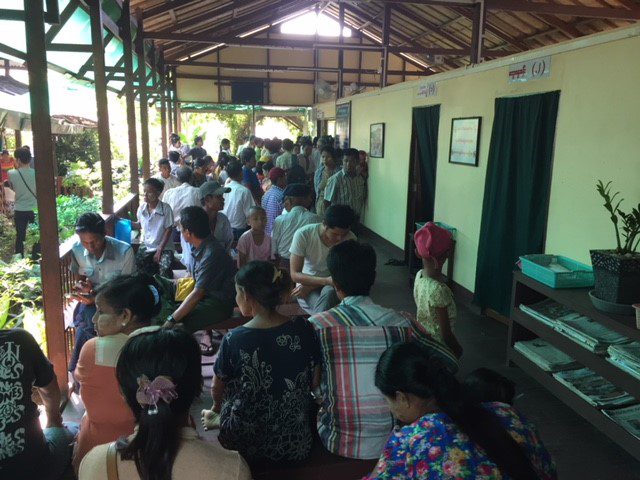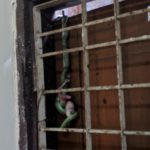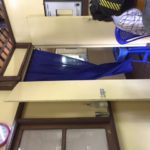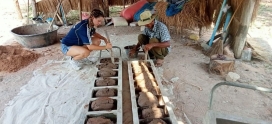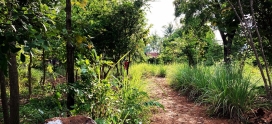Ed Wilkins in Myanmar- Week 27
There are many things that slip me by and snakes in the grass is one of them, mainly because except for the not-so-scary adder they don’t present a major public health hazard in the UK. Certainly, as far as I can remember how to deal with a green mamba snakebite is not part of the induction course for hospital docs in the Emergency department back home, nor does antivenom clutter up the drug cupboards. In fact, it’s my impression that not many of us have much of a penchant for snakes either to charm, to be adorned by, or even to have as a cuddly and much-loved pet.
I for one am happy to observe these slithering serpents from a distance, preferably in a zoo, but in the open I can’t recognise one slimy slinker from another and, if asked which snake I’d been envenomed by to get the correct antidote, I would be at a complete loss beyond large, wide, and long to small, skinny, and short. Indeed, one slipped in through the toilet window in the MAM Office not so long ago (picture 1): certainly, enough to stop even the most prostatic chap midstream, and only the most interested, short-sighted, or foolhardy would get a close look to obtain a species identification of the invader. Maybe I could just about muster a blurred mobile snap on exiting the loo but aside of a cry for help, that would be the sum of my contribution. My default position is that they’re all lethal – it’s just a question whether it’s by throttling or poison.
But this is a major problem in Myanmar where 70% of the population reside in rural areas with heavy reliance on subsistence agriculture and where being a hard-working farmer is a major occupational risk for the hungry grass-gliders (picture 2). To me their names are sufficient to underline my innate concerns: green-pit and Russell vipers, banded kraits, and spitting cobras are the common paddy-field rustlers in Myanmar, of which the Russell viper tops the emergency department’s bite-tally for the day (picture 3).
Snakebite is one of the top ten causes of death here and it is estimated that there are around 80,000 cases annually with over 2,000 deaths, most of which never make it to any healthcare centre or hospital. For 2016 in Mandalay where they see a fair few, there were just under a thousand persons admitted to hospital of whom 69% suffered from severe bleeding (the venoms often interfere with clotting), 63% acute kidney injury, 32% required dialysis, and alas 12% died. Indeed, it causes 70% of acute renal failure seen in the country’s kidney units. And of course, these are the lucky few who make it to the hospital. Many don’t manage the trip to any medical centre because of transport issues, not understanding the dangers of having a bite to eat before setting off or relying instead on traditional and faith healers. Methods used vary tremendously but may include asking the patient to chew the root of a specific plant (which hopefully grows nearby!) to diagnose which species of snake has bitten the unlucky person and then anything from herb ingestion, application of snake stones, chanting, or ‘emergency’ tattooing may be used.
Luckily there is now significant investment to achieve sustainable and sufficient locally-produced antivenom, improve its distribution and availability, and focus on improving knowledge and management in the local communities in high prevalence areas. Unfortunately, snakebite-proof wellington boots have not proven a hit with the farmers: they’re hot and sweaty and get stuck in the mud and in fact the fangs can sometimes pierce even the best of Barber Grand National specials.
As a relevant bridge to the next section, the new arrivals are all taught to knock hard on the dedicated staff squat-toilet door in the clinics to scare off the lurking fang-ready snakes, although there only seems to be one place they can slip off to which is a bit disconcerting. Luckily, for us blokes the diet is pretty fibre-free: not all are so lucky alas. Anyway, the clinics have continued to heat up so, it was with astonishment and significant relief, that I heard about a little coffee shop sweetly named Ambrosia (I’m sure because Ambrosia condensed milk goes into everything) which is just around the corner and where you can get most caloried-up goodies from a Danish pastry to a full-on knickerbocker glory. However incongruous it may seem given this is an incredibly deprived area, its key attribute of air conditioning is a tempter to even the most heat-resistant skin. Hence, I’m on the way to getting a loyalty card and have brought forward my dentist appointment back home as instructions for coffee without sugar is interpreted as coffee with more condensed milk to compensate. Still, twenty minutes of chillax time with a sugary coffee in an air conditioning room beats black tea with an intermittently working fan in the clinic: so, I’ll be off there for a cuppa on Monday.
Not much super-awesome has walked in to the clinic this week, which of course is good, although there certainly has been a flurry of patient activity post-water festival, mainly with minor ailments. I’ve often worried about the lack of privacy during the consultation which is nigh impossible given the open plan to the clinic (picture 4). Rightly, back home we place significant importance on this: no one wants hearing aids turned up to eavesdrop on their conversation with the doctor concerning their HIV or impotence. But above anything else, one must be pragmatic over here and, to stop the patients and staff slowly succumbing to the heat, there must be either air conditioning units in every room (not an option) or an open design to the consultation rooms.
Again, with that in mind, it was interesting to see on the weather app that the clinic was going to have ‘smoky’ conditions last week; a change from that repetitive sun emoji you see on checking the BBC app daily (which I’m now doing because the rains are not far away when the obligatory umbrella must be a permanent appendage). It then transpired that there was a smouldering rubbish tip nearby and for which the Fire Services Department had deployed more than 200 firefighters and 100 reserves as well as more than two dozen fire engines to try and tackle (picture 5). It has focused many government minds and bodies for this last week and even the army have been drafted in to help: control measures have included importing and injecting bio-foam from Thailand, and ‘simulating rain fall’ through a series of pipes. The fire has scorched more than 100 acres of the site and several people in the local area have been admitted to hospital with carbon monoxide poisoning with a few unfortunately dying. Happily, the fire is now coming under control. Nevertheless, clinic staff have now been instructed what to look out for if a patient does present with possible carbon monoxide poisoning: cherry-red lips is the classical feature (not to be confused with passion-pink lipstick as Myanmar is awash with beauty parlours even in the most deprived of areas).
Reading the blogs, and I’m afraid this one is no exception, there always seems to be a moment when I gravitate to one or possibly both of two things, my ailments and alcohol. You’ll be mightily relieved this week has been medically kind to me, but the latter is difficult to ignore completely. Often consumed at the local watering hole, which is affectionately known as the ‘white rabbit’ because this is the much beloved and cherished pet of the owner, it is a frequent place for the volunteers to congregate at the end of the day and aside of rehydrating to preserve their kidney function also discuss the day’s activities. Understandably, the poor rabbit must live off what she can find, and the most available and probably safest liquid is beer, which she laps up with alacrity. Hence, it’s not all bad for the animal, especially as in a flash she went from being a singleton in need of a soulmate to producing four lively offspring (not certain whether the proud owner knew about the health warnings of not drinking while pregnant). But, you can’t blame the rabbit – she has little choice. Not so for the locals and dare I mention the volunteers as alcohol is so cheap: in the supermarket today, two lemons purchased to add the final flourish to the evening gin and tonic cost more than half a bottle of gin, and they were only forty pence apiece!
Next week I’m doing a tour of the clinics, so I promise a few more pictures, a bit more medicine, and a few vignettes about the other volunteers. However, to end the week I’ll leave you with a real clinic problem. The picture shows a young lad I suspect has resistant TB (picture 7) but we’ve not been able to confirm this. It’s very difficult to get a biopsy of his lymph glands and the hospital where all patients with resistant TB go to won’t take a patient without confirmation of the bug being resistant. No different to the UK in this world of tick-boxes but the consequences here are so much worse.
Anyway, till next week and lots of pics.

